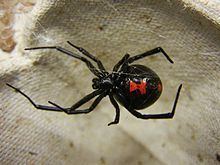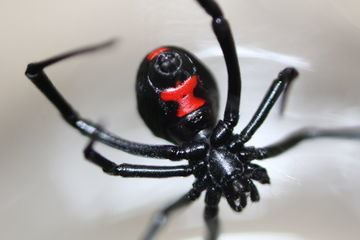Length Female: 3.8 cm | Order Araneae Lifespan 1 – 3 years Rank Species Diameter Female: 0.64 cm | |
Similar Widow spiders, Brown recluse spider, Recluse spider, Chilean recluse spider, Tarantula | ||
Handling a female black widow spider latrodectus mactans
Latrodectus mactans, known as the wheat spider, southern black widow or simply black widow, is a highly venomous species of spider in the genus Latrodectus. They are well known for the distinctive black and red coloring of the female of the species that will occasionally eat her mate after reproduction. The species is native to North America. The venom is seldom fatal to healthy humans.
Contents
- Handling a female black widow spider latrodectus mactans
- Taxonomy
- Description
- Range
- Reproduction
- Prey
- Natural enemies
- Toxicology
- References

Taxonomy

Latrodectus mactans was first described by Johan Christian Fabricius in 1775, placing it in the genus Aranea. It was transferred to the genus Latrodectus in 1837 by Charles Walckenaer and is currently placed in the Theridiidae family of the order Araneae. The species is closely related to Latrodectus hesperus (western black widow) and Latrodectus variolus (northern black widow). Members of the three species are often confused with the genus Steatoda, the false widows. Prior to 1970, when the current taxonomic divisions for North American black widows were set forth by Kaston, all three varieties were classified as a single species, L. mactans. As a result, there exist numerous references which claim that "black widow" (without any geographic modifier) applies to L. mactans alone. Common usage of the term "black widow" makes no distinction between the three species.
Description

The body length (excluding legs) of the mature female is 8–13 mm (0.31–0.51 in), 3–6 mm (0.12–0.24 in) for males. Legs are long in proportion to body. Females are shiny and black in color, with a red marking in the shape of an hourglass on the ventral (under) side of her very rounded abdomen. There is much variation in female size, particularly in egg-carrying (gravid) females. The abdomen of a gravid female can be more than 1.25 cm (0.5 in) in diameter. Many female widows also have an orange or red patch just above the spinnerets on the top of the abdomen. Juveniles have a distinctly different appearance from the adults; the abdomen is grayish to black with white stripes running across it and is spotted with yellow and orange. Males are either purple, or closer to the appearance of the juveniles in color.
The web of the black widow spider is a three-dimensional tangled cobweb of exceptionally strong silk.
Range

The southern widow is primarily found in (and is indigenous to) the southeastern United States, ranging as far north as Ohio and as far west as Texas. The northern black widow (L. variolus) is found primarily in the northeastern United States and southeastern Canada, though its range overlaps with that of L. mactans. In Canada, black widows range in the southern parts of British Columbia, Alberta, Saskatchewan, Manitoba and Ontario. In the Dominican Republic it is found throughout the whole country.

Latrodectus mactans, along with Latrodectus hesperus and Latrodectus geometricus (the "brown widow spider"), is established in the Hawaiian Islands (USA). One pathway of entry into Hawaii for at least one of these black widow species is imported produce (which is also considered an important potential pathway for widow spiders elsewhere).
Reproduction
When a male is mature, he spins a sperm web, deposits semen on it, and charges his palpal bulbs with the sperm. Black widow spiders reproduce sexually when the male inserts his palpal bulbs into the female's spermathecal openings. The female deposits her eggs in a globular silken container in which they remain camouflaged and guarded. A female black widow spider can produce four to nine egg sacs in one summer, each containing about 100–400 eggs. Usually, eggs incubate for twenty to thirty days. It is rare for more than a hundred to survive this process. On average, thirty will survive through the first molting, because of cannibalism, lack of food, or lack of proper shelter. It takes two to four months for black widow spiders to mature enough to breed, however full maturation typically takes six to nine months. The females can live for up to three years, while a male's lifespan is about three to four months. The female may eat the male after mating.
Prey
Black widow spiders typically prey on a variety of insects, but occasionally they do feed on woodlice, diplopods, chilopods and other arachnids. The spider's web is even strong enough to catch animals as large as mice. When the prey is entangled by the web, Latrodectus mactans quickly comes out of its retreat, wraps the prey securely in its strong web, then bites and envenoms its prey. The venom takes about ten minutes to take effect; in the meantime, the prey is held tightly by the spider. When movements of the prey cease, digestive enzymes are released into the wound. The black widow spider then carries its prey back to its retreat before feeding.
Natural enemies
There are various parasites and predators of widow spiders in North America, though apparently none of these have ever been evaluated in terms of augmentation programs for improved biocontrol. Parasites of the egg sacs include the flightless scelionid wasp Baeus latrodecti, and members of the chloropid fly genus Pseudogaurax. Predators of the adult spiders include a few wasps, most notably the blue mud dauber, Chalybion californicum, and the spider wasp Tastiotenia festiva. Other species including Mantis or Centipede also will occasionally and opportunistically take widows as prey, but the preceding all exhibit some significant specific preference for Latrodectus.
Furthermore, in 2012, researchers published a paper suggesting that the black widow's close relative, the brown widow, may be competing for territory with, and ultimately displacing black widows in Southern California.
Toxicology
Although the reputation of these spiders is notorious and their venom does affect humans, only mature females pose a serious threat to people; their chelicerae—the hollow, needle-like mouthparts that inject venom—are, at approximately 1 mm., or .04 in., long enough to inject venom into humans, unlike those of the much smaller males. The actual amount injected, even by a mature female, is variable. When this small amount of venom travels throughout the body, it acts explosively on nerve endings, causing the very unpleasant symptoms of latrodectism. Deaths in healthy adults from Latrodectus bites are exceedingly rare, with no deaths despite two thousand bites yearly. On the other hand, the geographical range of the widow spiders is vast. Epidemics of mostly European Widow spider bites had been recorded from 1850 to 1950, and during that time period, deaths were reported from 2/1000 to 50/1000 bites. Deaths from the Western Black Widow had been reported as 50/1000 in the 1920s. At that same time, antivenom was introduced. The LD-50 of L. mactans venom has been measured in mice as 1.39 mg/kg, and separately as 1.30 mg/kg (with a confidence interval of 1.20–2.70).
There are a number of active components in the venom:
The venom is neurotoxic.
